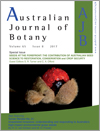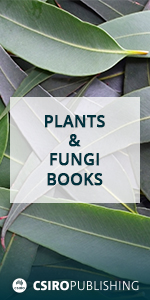
Australian Journal of Botany
Volume 65 Number 8 2017
RESEARCH FRONT: Seeds at the Forefront: the Contribution of Australian Seed Science to Restoration, Conservation and Crop Security
BT17096Saving rainforests in the South Pacific: challenges in ex situ conservation

Rainforests in the South Pacific are under threat as a result of ongoing logging, clearing for agriculture or mining, introduced species and other anthropogenic sources. Ex situ conservation offers a means to prevent the extinction of rainforest plants and provide a source of material for ecosystem restoration. Preliminary research to determine which species are suitable for seed banking, and which require alternative conservation methods, is urgently required.
BT17096 Abstract | BT17096 Full Text | BT17096PDF (1.6 MB) | BT17096Supplementary Material (1.6 MB) Open Access Article
BT17036Seed dormancy and germination of three grassy woodland forbs required for diverse restoration

Restoration is vital for the re-establishment of degraded communities, but success is often hindered by issues related to seed biology. We examined dormancy-alleviation and germination-promotion techniques for three common grassy woodland forbs required for diverse restoration. Scarification of the seed produced the highest germination for Dianella longifolia and Stackhousia monogyna, whereas germination of Dianella revoluta requires further examination. This information can advance methods to propagate these species from seed and contribute to greater understorey diversity in grassy woodland restoration.
BT16236Priorities for enhancing the ex situ conservation and use of Australian crop wild relatives

Contributions by Australia’s crop wild relatives to plant breeding are dependent upon their availability for research via genebanks, yet the comprehensiveness of genebank collections for these species has not been assessed. We determined the state of representation of Australia’s major food crop wild relatives in ex situ conservation, identifying the gaps needing to be filled and outlining the key activities required to more fully safeguard their diversity and to increase their use.
BT17154Benefits of adopting seed-based technologies for rehabilitation in the mining sector: a Pilbara perspective

Many aspects of seed biology are often overlooked in large-scale rehabilitation programs leading to the inefficient use of seed, and, consequently, limited plant establishment success. Through targeted research programs, a large body of empirical seed-use knowledge is now available to the mining and rehabilitation sector. In this paper we highlight how this knowledge has been used to improve direct seeding practices, through large-scale seed procurement, improved seed storage protocols, seed dormancy classification for over 100 species, effective pre-treatments to promote germination, and topsoil and growth media management research
BT17155Seed ecology informs restoration approaches for threatened species in water-limited environments: a case study on the short-range Banded Ironstone endemic Ricinocarpos brevis (Euphorbiaceae)

Translocation of threatened species is challenging, especially when using direct seeding for in-situ establishment. Within Australia, ~14% of threatened species translocations use directly sown seeds with unpredictable and highly variable results. Using laboratory and field experiments, we focussed on understanding the relative importance of temperature, moisture, light, germination stimulants and sowing depth to develop a detailed seed ecology profile of the threatened shrub, Ricinocarpos brevis. Moisture was identified as the primary factor regulating germination and in situ emergence. With this knowledge, strategies to deal with this limitation can now be developed and implemented for future translocation success.
BT17152Unassisted invasions: understanding and responding to Australia’s high-impact environmental grass weeds

Alien grass species are among the worst environmental weeds in Australia. We analysed the 339 currently naturalised species and found 17 to seriously impact diverse environments across Australia. Available evidence suggests their success was assisted by ecological novelty, high propagule pressure and an ability to respond to, and even alter, natural disturbance regimes. New management approaches will be needed to negate these natural advantages.
BT17152 Abstract | BT17152 Full Text | BT17152PDF (1.4 MB) | BT17152Supplementary Material (123 KB) Open Access Article



